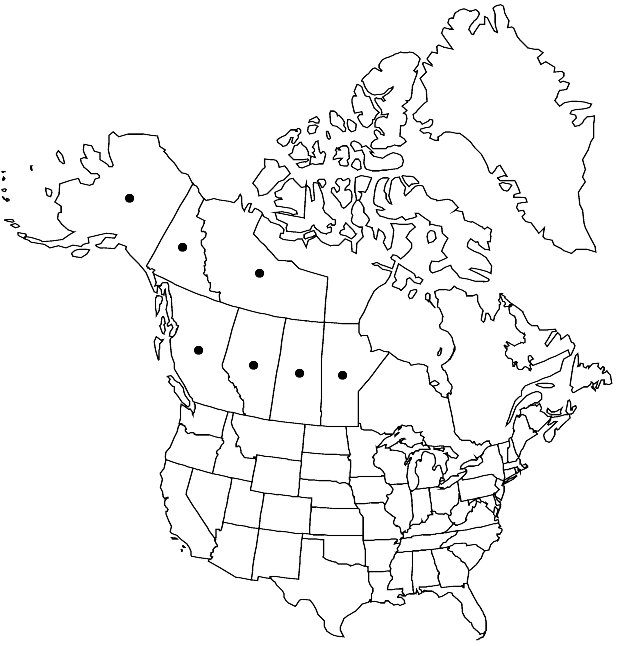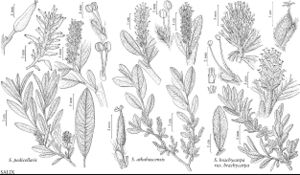Difference between revisions of "Salix athabascensis"
Rhodora 32: 111, plate 202. 1930.
FNA>Volume Importer |
FNA>Volume Importer |
Revision as of 22:56, 16 December 2019
Plants 0.6–1.3 m, not clonal. Stems erect; branches gray-brown, hairy; branchlets red-brown, sparsely or moderately densely pubescent, (buds alba-type). Leaves: stipules absent or rudimentary on early ones, usually rudimentary, rarely foliaceous, on late ones; petiole (shallowly grooved adaxially), 3–10 mm, (puberulent or villous); largest medial blade oblong, narrowly elliptic, elliptic, oblanceolate, or obovate, 17–50 × 8–18 mm, 1.9–3.2 times as long as wide, base cuneate or convex, margins flat or slightly revolute, entire, apex acuminate or convex, abaxial surface glabrescent or sparsely silky, hairs appressed or somewhat spreading, (usually white, sometimes also ferruginous), straight or wavy, adaxial dull or slightly glossy, glabrous, glabrescent, pilose, or sparsely long-silky along midribs and margin, (hairs usually white, sometimes also ferruginous, appressed); proximal blade margins entire; juvenile blade sparsely to moderately densely villous or long-silky abaxially (hairs usually white, sometimes also ferruginous). Catkins: staminate 14–31 × 8–18 mm, flowering branchlet 1.5–9 mm; pistillate loosely flowered, stout to globose, 10–58 × 7–25 mm, flowering branchlet 3.5–26 mm; floral bract tawny, 1–1.6 mm, apex rounded, entire, abaxially sparsely hairy, almost glabrous, hairs wavy. Staminate flowers: abaxial nectary (0–)0.3–0.6 mm, adaxial nectary oblong or ovate, 0.4–1.2 mm, nectaries distinct; filaments distinct, hairy basally or on proximal 1/2; anthers globose, 0.4–0.6 mm. Pistillate flowers: abaxial nectary absent, adaxial nectary oblong, 0.4–1.3 mm, shorter than stipe; stipe 0.8–1.3 mm; ovary pyriform, very densely long-silky, beak gradually tapering to or slightly bulged below styles; ovules 6–14 per ovary; styles 0.5–1 mm; stigmas flat, abaxially non-papillate with rounded tip, or broadly to slenderly cylindrical, 0.28–0.35–0.48 mm. Capsules 5.6–7.2 mm. 2n = 76, 95, 114.
Phenology: Flowering late May-late Jul.
Habitat: Fens, bogs, and treed bogs
Elevation: 0-1800 m
Distribution

Alta., B.C., Man., N.W.T., Sask., Yukon, Alaska.
Discussion
The three polyploid chromosome numbers reported for Salix athabascensis, as well as the presence of leaves with ferruginous hairs, otherwise unknown in sect. Myrtilloides, are indicators of allopolyploidy.
Hybrids:
Salix athabascensis forms natural hybrids with S. pedicellaris. These hybrids combine the characteristics of the parents. The ovaries may be moderately densely villous or glabrous, but commonly have hairs in patches, or the stipes may be hairy and the ovaries glabrous; juvenile blades, and sometimes mature leaves, are hairy with white and ferruginous hairs. Some plants that resemble S. athabascensis have leaves glaucous adaxially, as in S. pedicellaris. The ovaries often appear to be infertile.
Selected References
None.
